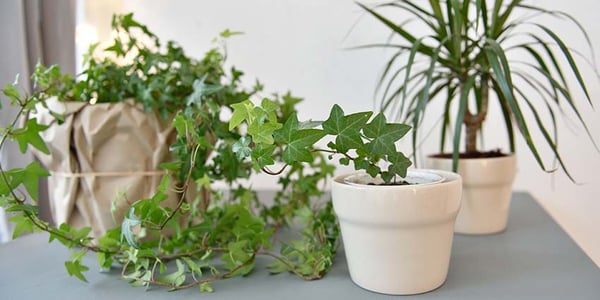It’s a pain trying to keep finicky plants alive. Here’s a list of low maintenance indoor plants that’ll give you the benefits of an indoor garden - without needing a green thumb.

Indoor plants are beautiful and beneficial to our health. However, they can also be quite difficult to maintain, unless you know which plants fare well indoors. Here’s a list of 8 low-maintenance indoor plants, that will liven up your living space, cleanse the air in your home, and help your family stay happy and healthy.
BOSTON FERN

Boston Ferns basically only require two simple things to ensure ideal living conditions: indirect sunlight and a cool, humid room. They enjoy medium exposure to sunlight and can grow to be up to four feet tall if planted in a large enough pot. These plants stay green all year round, and are way tougher than their lacy leaves let on… Keep your ferns moist (but not soaked), and you’ll have a luscious, classic display of intricate, arched fronds for decades to come.
CALATHEA

Looking to add a pop of color to a room? Calathea (otherwise known as the prayer plant) is famous for its bright, mottled leaves. Calathea comes in all sorts of vibrant colors, including yellow, rose, green, and white. Each plant is unique, and the mottled leaves vary from spots or blotches to stripes.
Calathea grows in low-light conditions and should be kept out of direct sunlight. This is why it grows so well indoors.
ENGLISH IVY

English Ivy is both beautiful and extremely functional inside the home. This romantic-looking creeper is highly effective as an air purifier and can reduce airborne mold (responsible for asthma and allergies) by up to 60%.
English Ivy is easy to propagate (by simply taking a five-inch cutting, and putting it in moist soil) and even easier to look after. It enjoys medium to direct sunlight and should be kept moist. As a creeper, Ivy is particularly well suited to being grown vertically, as the stems will drape downwards, creating a shower effect.
It’s important to note, however, that Ivy is poisonous if ingested, so it’s not a great option if you have small children or pets that are likely to eat the leaves.
KALANCHOE

With its delicate flowers, Kalanchoe might look very dainty, but it’s a hardy little plant. There are loads of varieties of Kalanchoe, from red to pink, orange, yellow and white, and they’re a great choice to add splashes of color to a room.
Being a succulent, they don’t need much water to survive. Even the most forgetful plant owner is unlikely to kill their Kalanchoe.
PEPEROMIA

Peperomias are a variety of attractive, mottled creepers, which grow well in medium to full sunlight. They have a slightly waxy-textured leaf, which helps them to store water - making them much harder to accidentally kill. Peperomias have beautifully variegated leaves and can create a brilliant display - especially if grown vertically.
PHILODENDRON

Known for its stunning heart-shaped leaves, the Philodendron is another hardy indoor creeper. This particularly tough species will survive a holiday or two - so you won’t come home to a pot filled with parched sticks and sand. There are many different varieties of the Philodendron, which come in all sorts of shapes and sizes, all of which can handle their fair share of neglect.
However, like English Ivy, this creeper is poisonous when ingested - so it’s not a good choice for parents of small children or pet owners.
POTHOS

Pothos (also known as Devil’s Ivy), like the Philodendron (with which it’s often confused), has a distinctive heart-shaped leaf. It’s a great beginner plant and can tolerate low light - so it can survive in bathrooms and offices. The level of variegation in the leaves depends on how much light the room gets - the better the lighting, the more exciting the patterns will get.
SHAMROCK PLANT

Bring a little Irish luck into your home by planting Shamrocks. These cheerful little plants sprout delicate white blossoms and grow well in a cool space with indirect lighting. They only need to be watered about once a week (depending on climate), making them an easy plant to care for.
SPIDER PLANT

Spider plants (also known as hens and chicks) enjoy medium light, moist soil, and moderate temperatures. If you can get these three things right, you’ll have a constant supply of happy greenery in your home.
These self-propagating plants are easily identifiable by their green and white striped leaves. Their “babies” sprout, like spider webs, in tendrils from the main plant and, can be re-potted to start new plants. Spider plants have been popular for decades, and add a very vintage appeal to a room.
HOW TO PERFORM A MOISTURE TEST

You can check if your plant’s soil is moist by simply poking a hole in the soil with your finger. The soil should feel cool and damp - if you can feel a lot of water, you’ll need to drain the pot. Over watering will kill your plants just as fast as under watering.
GrowUp’s green wall system is cleverly designed to protect against overwatering, using drip irrigation technology. Water drips from one layer to the next, ensuring that each pot receives the perfect amount of water.

![Seasonal Planting Guide [Prep for Winter]](https://blog.growup.green/hubfs/Seasonal%20planting%20guide%20%5Bprep%20for%20Winter%5D.png)

